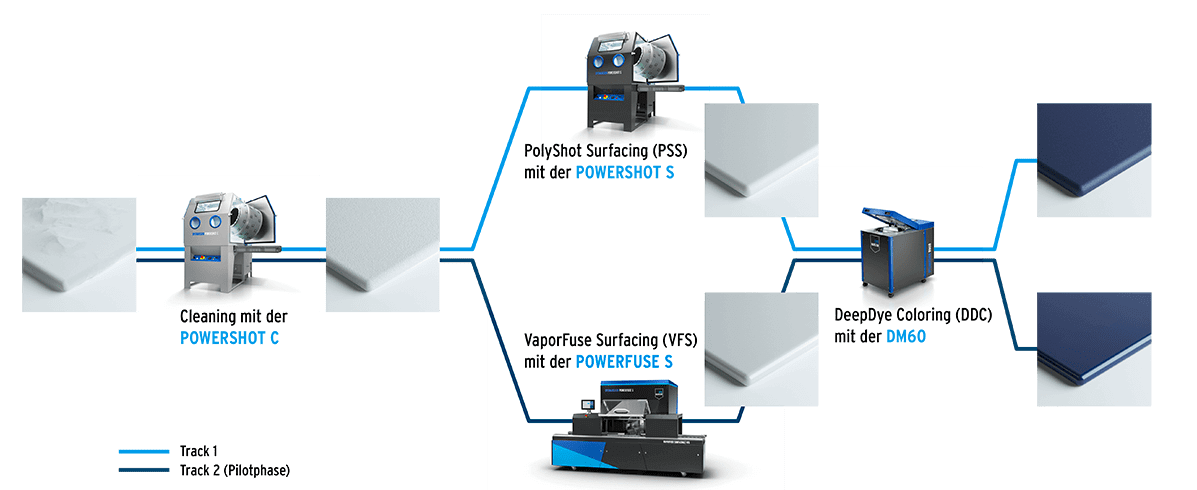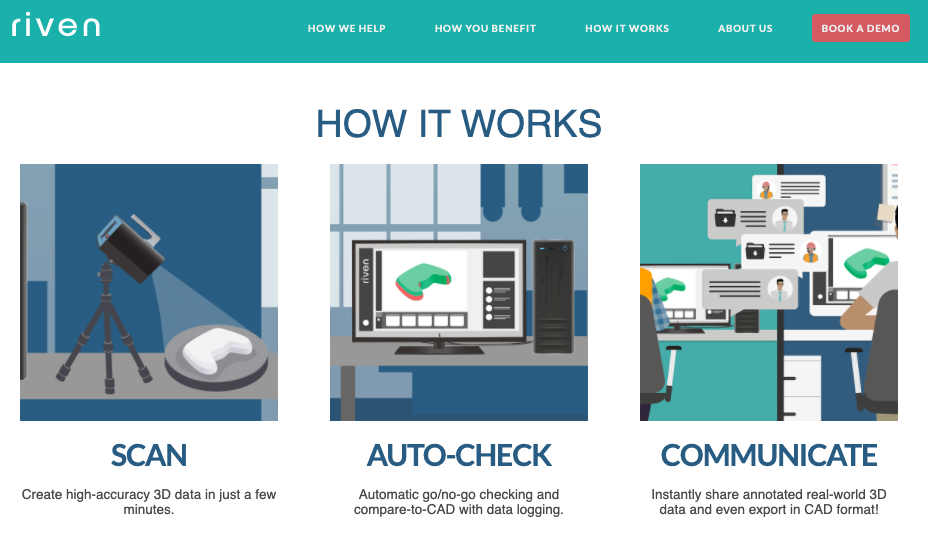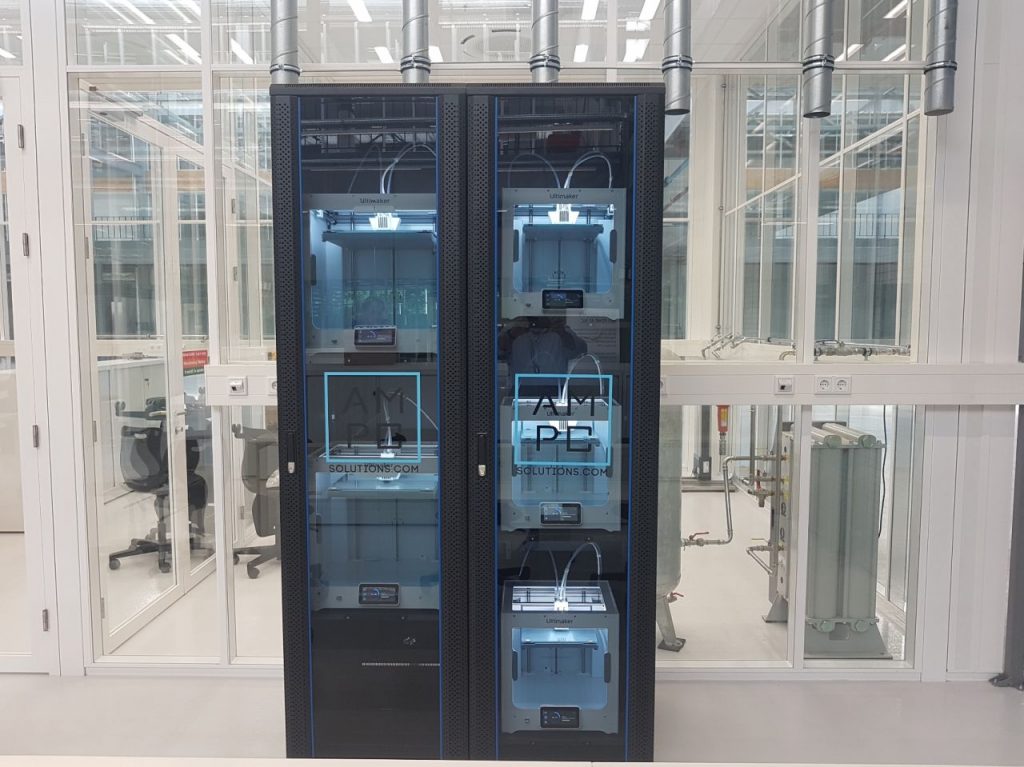As exciting as all of the verticals discussed at the online Additive Manufacturing Strategies summit were, automation is a personal favorite as it addresses the gaps between 3D printing and traditional manufacturing methods. In many ways, additive technology represents the dream of an automated factory (including both problems associated with disempowering labor and the benefits of democratizing access to production). However, additive manufacturing (AM) is far from realizing that dream. And, as we learned from the AMS summit, addressing these gaps will likely include post processing solutions and new software.
In his afternoon keynote, PostProcess CEO Jeff Mize explained that 46 percent of some businesses’ additive manufacturing (AM) costs are associated with post-processing, according to the company’s 2nd Annual Additive Post-Printing Trends Report. In particular, vat photopolymerization technologies represent over 51 percent of that expenditure, followed by powder bed fusion.
Post-processing, therefore, represents a huge gap in terms of automating the fabrication of parts, as they require costly and labor-intensive techniques to remove items from the build area, clean them (including the removal of support structures) and then applying any necessary techniques for finalizing their appearance. And, as discussed in Panel 3 on Post Processing (hosted by Todd Grimm), many companies don’t even realize that post-processing is a thing when they jump into AM. Both Mize and Felix Ewald, CEO and CO-Founder of DyeMansion, said in that panel that what happens to a part after it’s printed is often an afterthought for customers.
PostProcess tackles this with a combination of hardware, software and materials. CONNECT3D is the company’s software for managing post-processing steps. This includes support and resin removal from fused deposition modeling, vat photopolymerization and inkjet polymer parts using chemical spray or submersion hardware, as well as surface finishing through the use of abrasion media and chemicals. All of this is meant to be further optimized using the firm’s AUTOMAT3D software, which monitors and reacts to the finishing processes.
DyeMansion grew from focusing on dying parts made with selective laser sintering (SLS) to address multiple parts of the post-processing workflow, from cleaning and surfacing all powder bed fusion (PBF) parts, including Multi Jet Fusion, to deep-dye coloring.
Obviously, the automation of these steps preps 3D printing to be adopted as a mass manufacturing technology. However, neither company yet offers coating technology, so there is plenty of niche to go around. In fact, because these two businesses only address polymer parts at the moment, there will also need to be solutions for metal 3D printing.
In Panel 1: Design Software for AM, this was addressed to some degree by such developers as AdditiveLab, Autodesk and Riven. Riven’s founder and CTO Jeff Page has a unique approach in that Riven takes information from actual produced parts via 3D scanning to determine what issues occurred and how to correct them in the design process.
AdditiveLab means to aid in the industrialization of AM through its metal 3D printing simulation software. This area is a fast growing one, with several firms now developing tools for the simulation of metal parts before they’re printed; however, tools like ANSYS are rather advanced and costly. Co-founder Mariam Mir explained how the software is democratizing access to simulation and thus opening metal AM up to more users.
Kevin Acker, Senior Technical Consultant at Autodesk, obviously believes that his employer is playing a role in this democratization, as well, given the fact that tools like Fusion 360 are free to educational users and hobbyists. But a theme that emerged throughout the day, and which Acker touched on in this discussion, is that the constraints of various production technologies need to be increasingly built into design software so that users more easily understand those limitations as they design.
In fact, this was a major highlight of Panel 2: Workflow and Automation Software for AM, which was the liveliest of the events for the afternoon—in part due to the moderation of Executive Vice President of Research at SmarTech Analysis Scott Dunham and also due to the chemistry between participants. As the one participant managing daily production lines of additive parts, David Tucker, Director of Digital Solutions for Forecast 3D, fielded a number of questions from his fellow panel members about how exactly we can industrialize AM via automation.

Unfortunately, AM-Flow’s Stefan Rink dropped out due to poor internet connection, but the company is attempting to tackle everything from part identification and sorting to packaging in an automated fashion. Joris Peels discusses the company in greater depth here. If anything, this firm may be key to automating AM factories. Image courtesy of AM-Flow.
Related to Acker’s point about designing with constraints in mind, Tucker explained that, when he previously worked in injection molding, he realized that the best designs are ones that consider the production process when they are being modeled. This was something he believed needed to be carried into AM, with designers actually thinking about if an item will be made via PBF, vat photopolymerization, etc. Moreover, even materials and machine companies need to think about where their machines are being used. Tucker pointed out that OEMs are still thinking of their systems in terms of prototyping:
“There are control points that are being created in the industry from a material or machine manufacturer standpoint. Many times, they don’t understand what the factory looks like or what scaled manufacturing looks like. They’re negotiating prices for small additive manufacturing machines for prototyping and we’re expecting those business models to scale into production. To be honest, they break apart, they fall apart. They keep additive in the prototype area.”
All participants—including Stefan Rink, CEO of AM-Flow; Arno Gramsma, Co-founder of AMPC Solutions b.v; and Todd Grimm, President of T. A. Grimm & Associates, Inc.—agreed with this point.
Grimm’s point about digitizing tribal knowledge into design software related directly to Tucker’s point:
“I’m really excited about where software is and where it’s going because I see it addressing a lot of challenges that are obstacles for the adoption of additive in two key areas: one is that transference from tribal knowledge or hands-on experience into something that the software takes care of the thinking for us as individuals and the other one is taking away the tedious or the very involved, such as scheduling,” Grimm said.
Rink said that the challenge for AM is that it is trying to be a high volume, high mix production technology when, up until now, it has been better suited as a high mix, low volume technology, compared to something low mix and high volume, like injection molding. In essence, he said, “It’s like wanting a factory to manufacture both a BMW Mini and Boeing 747.”
Gramsma said that AMPC is attempting to address the automation problem by developing solutions for desktop factories. For now, this means lockable cabinets to filter dangerous particles out of the production environment, as well as emergency stop features, temperature and humidity control.
However, according to Todd Grimm, there still needs to be some sort of centralization, possibly application programming interfaces (APIs) that allow users to more easily incorporate 3D printers into a factory environment. He compared it to his time in CAM years ago, in which customers would have to have code written specifically for their workshops, rather than use a general gCode to drive their equipment.
All of this linked to what was discussed in Panel 4: AM in the Context of Industry 4.0, with Al Siblani, President and CEO of EnvisionTEC (recently acquired by Desktop Metal), noting that artificial intelligence (AI) will have to play an increasing role in how all of this is done. Siblani has played a key role in the industrialization of polymer AM as his firm has seen the mass production of hearing aids and clear dental aligners through the use of 3D printing.
Jonah Myerberg, Co-Founder and Chief Technology Officer of Desktop Metal, agreed that AI will increasingly be used to perform such tasks as in-process quality control via machine vision. He further suggested that these automation technologies are developing in concert with AM processes. Mike Vasquez, Founder and CEO of 3Degrees, raised an interesting point in terms of these advances: will small-to-medium businesses (SMBs) be left behind due to the cost of AI and similar technologies or will they help pull these SMBs along?
My feeling is that, as these new technologies develop, the cost of many of them will decrease, allowing SMBs to join the fray. For instance, AdditiveLab is presenting simulation software that is less expensive than that offered by ANSYS and I sense that there will be greater competition looking to drive these costs down. In turn, 3D printing will move further toward automation. What that means for the world at large remains to be seen, but hopefully it’s a good thing!
Subscribe to Our Email Newsletter
Stay up-to-date on all the latest news from the 3D printing industry and receive information and offers from third party vendors.
You May Also Like
3D Printing News Briefs, April 13, 2024: Robotics, Orthotics, & Hypersonics
In 3D Printing News Briefs today, we’re focusing first on robotics, as Carnegie Mellon University’s new Robotics Innovation Center will house several community outreach programs, and Ugogo3D is now working...
Rail Giant Alstom Saves $15M with 3D Printing Automation Software 3D Spark
3D Spark has entered into a three-year deal with the rail giant Alstom. Alstom, a transport behemoth with annual revenues of $16 billion, specializes in the manufacture of trains, trams,...
Meltio Expands Global Reach with New Partnerships in the Americas and Europe
Spanish 3D printing manufacturer Meltio has expanded its sales network across the globe. With the addition of three new partners in the United States, Brazil, Argentina, and Italy, Meltio aims...
3D Printing Webinar and Event Roundup: April 7, 2024
Webinars and events in the 3D printing industry are picking back up this week! Sea-Air-Space is coming to Maryland, and SAE International is sponsoring a 3D Systems webinar about 3D...



































